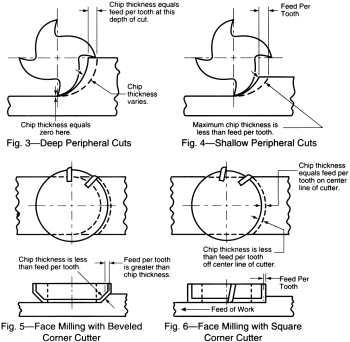Speeds and feeds are the most important factors to consider for best results in milling. Improper feeds and speeds often cause low production, poor work quality and unnecessary wear to the cutter.
This section covers the basic principles of speed and feed selection for milling cutters and end mills. It will serve as a guide in setting up new milling jobs.
In milling, speed is measured in peripheral feet per minute, (revolutions per minute times cutter circumference in feet). This is frequently referred to as a "peripheral speed," "cutting speed," or "surface speed."
The figures given in Table 1 are suggested starting speeds only. They are based on cutting conditions. For example:
| Use Lower Speed Ranges for | |
|---|---|
| Hard materials | Heavy cuts |
| Tough materials | Minimum tool wear |
| Abrasive materials | Maximum cutter life |
| Use Higher Speed Ranges for: | |
|---|---|
| Softer materials | Frail work pieces or set-ups |
| Better finishes | Hand feed operations |
| Smaller diameter cutters | Maximum production rates |
| Light cuts | Non-metallics |
| WORK MATERIAL | TOOL MATERIAL | WORK MATERIAL | TOOL MATERIAL | ||
|---|---|---|---|---|---|
| High Speed Steel |
Cemented Carbide |
High Speed Steel |
Cemented Carbide |
||
| Magnesium | 600 up | 1000 up | Titanium: | ||
| Aluminum | 600 up | 1000 up | Under 100,000 PSI | 35 -55 | 150 -180 |
| Copper | 300 up | 1000 up | 100,000 to 135,000 PSI | 25 - 35 | 120 -150 |
| Brass | 300 | 800 | 135,000 PSI & Over | 15 -25 | 80 -120 |
| Bronze | 200 | 400 | High Tensile Steels: | ||
| Malleable Iron | 100 | 350 | 180,000 - 220,000 PSI | 25 -40 | 200 -250 |
| Cast Iron | 100 | 300 | 220,000 - 260,000 PSI | 10 -25 | 110 -200 |
| Cast Steel | 70 | 200 | 260,000 - 300,000 PSI | 6 -10 | 90 -180 |
| Steel -100 Brinell | 150 | 450 | High Temperature Alloys: | ||
| Steel -200 Brinell | 70 | 350 | Ferritic Low Alloys | 40 -60 | 150 -300 |
| Steel -300 Brinell | 40 | 200 | Austenitic Alloys | 20 -30 | 100 -235 |
| Steel -400 Brinell | 20 | 100 | Nickel Base Alloys | 5 -20 | 50 -150 |
| Steel -500 Brinell | 10 | 75 | Cobalt Base Alloys | 5 -10 | 50 -100 |
| Stainless Steel: | |||||
| Free Machining | 70 | 400 | |||
| Other | 40 | 300 | |||
| Feeds | |
| CHIP THICKNESS - Chip thickness is one of the more important factors affecting tool life in milling operations. Very thin, or feather-edge chips dull cutting edges more rapidly than thick chips. Chip thickness is governed by the size and shape of the cutter and work piece. Chip thickness is affected by the feed per tooth. Figures 3 - 6 illustrate the relation of chip thickness to feed per tooth, for several conditions. It emphasizes that careful thought must be given to feed per tooth, to cutter size and design and relative location to the work. |  |
